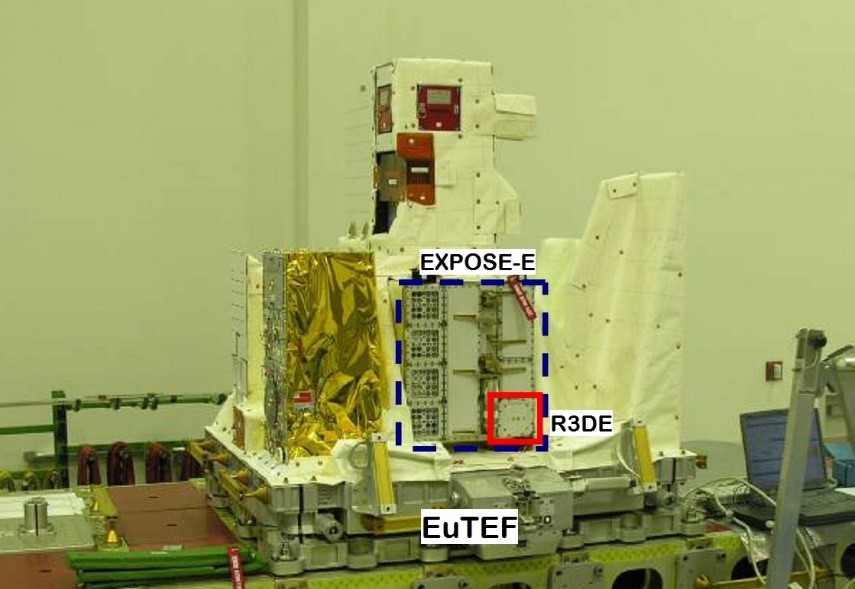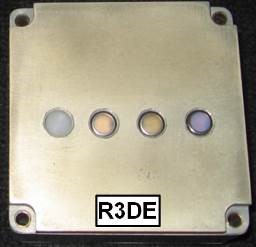R3DE, Inside ESA EXPOSE-E, Outside “Columbus” module of ISS
Satellite provider: ESA
Experiment name: EXPOSE-E<
Instrument name: R3DE
Cooperation: Bulgaria, Germany
Begin-end of data: 17/02/2008-01/09/2009
PI/CoPI: G. Horneck, DLR; D. Häder, UE; Ts. Dachev, SRTI
Main description Reference:
Horneck et al., 1998), http://adsabs.harvard.edu/abs/1999uiss.conf..459H
Dachev et al., 2012), http://eea.spaceflight.esa.int/attachments/spacestations/ID501800a9c26c2.pdf
Units: Size [mm]/Mass [kg]: 1 DU (76x76x36 mm, 0.17 kg)
Place, Outside of ISS in the EXPOSE-E facility in EuTEF
Shielding [g cm-2]: >0.6 g cm-2
Resolution [sec]/[min]: 10 s


External view of EuTEF with EXPOSE-E and R3DE


External view of R3DE instrument


Block-diagram of R3DE instrument.
Dose measurement algorithms and formulas*
Dose measurement algorithms and formulas
The main measured parameter in the R3DE instrument is the amplitude of the pulse after the CSA, generated by a particle or a photon partially or fully crossing the detector (Dachev et al., 2002). The amplitude of the pulse is proportional by a factor of 240mV/MeV to the energy deposited in the detector and to the dose, respectively. These amplitudes are digitized in an 8-bit ADC and organized in a 256-channel deposited energy spectrum.
By definition the dose in the silicon detector DSi [Gy] is one joule deposited in 1 kg of matter. The MDUs absorbed dose is calculated by dividing the summarized energy deposition in the spectrum in joules by the mass of the detector in kilograms:

where K is a coefficient. MD is the mass of the detector, and Eli is the energy loss in Joules in channel i. The energy in MeV is proportional to the amplitude A of the pulse: Eli [MeV] =A [V]/0.24 [V/MeV], where 0.24 [V/MeV] is a coefficient dependent on the preamplifier used and its sensitivity.
All 255 deposited dose values, depending on the deposited energy for one exposure period, form the deposited energy spectrum. Channel 256 accumulates all pulses with amplitudes higher than the upper energy of 20.83MeV measured by the spectrometer. The methods for characterization of the type of incoming space radiation are described in Dachev (2009), http://dx.doi.org/10.1016/j.asr.2009.08.007; and Dachev et al. (2017), https://doi.org/10.1002/2016SW001580.
“DATA SOURCES” string description
UT date and time (DD/MM/YYYY hh:mm:ss); A/D Asc./Desc.; ALT (altitude (km); longitude (deg)] latitude (deg); L value; total magnetic field strength B (Gauss); MLT (hours); DIPL dip latitude (deg); INLAT invariant latitude (deg); F flux (1/cm2 s); D absorbed dose rate (µGy/hour); D/F (nGy cm2 particle-1); PE proton energy (MeV); H* total apparent ambient dose equivalent rate H*(10) (µSv/hour), H*l calculated low energy component of H*(10)low (µSv/hour); H*h high energy component of H*(10)high (µSv/hour); ch1-ch237, ch255. All files are in csv format.
Link to the full text “DATA SOURCES” files: http://esa-pro.space.bas.bg/datasources/R3DE
Additional references, concerning R3DE data:
Dachev, T., G. Horneck, D.-P. Häder, M. Lebert, P. Richter, M. Schuster, R. Demets, Time profile of cosmic radiation exposure during the EXPOSE-E mission: the R3D instrument, Journal of Astrobiology, 12, 5, 403-411, 2012. http://dx.doi.org/10.1089/ast.2011.0759 http://eea.spaceflight.esa.int/attachments/spacestations/ID501800a9c26c2.pdf
Dachev Ts., Analysis of the space radiation doses obtained simultaneously at 2 different locations outside ISS, Adv. Space Res., 52, 1902-1910, 2013 http://dx.doi.org/10.1016/j.asr.2013.08.011
Dachev, T.P., Profile of the ionizing radiation exposure between the Earth surface and free space, Journal of Atmospheric and Solar-Terrestrial Physics, 102, September 2013, 148–156, 2013, 1.596 http://dx.doi.org/10.1016/j.jastp.2013.05.015
Dachev, T.P., J.V. Semkova, B.T. Tomov, Yu.N. Matviichuk, Pl.G. S. Maltchev, R. Koleva, Pl., Dimitrov, N.G. Bankov, V.V., Shurshakov, V.V., Benghin, E.N., Yarmanova, O.A. Ivanova, D.-P. Häder, M.T. Schuster, G. Reitz, G. Horneck, Y. Uchihori, H. Kitamura, O. Ploc, J. Kubancak, I. Nikolaev, Overview of the Liulin type instruments for space radiation measurement and their scientific results, 92–114, 2015. http://dx.doi.org/10.1016/j.lssr.2015.01.005
Schuster, M., Ts. Dachev, P. Richter, D.-P. Häder, M. Lebert, R3DE, Radiation risk radiometer-dosimeter On the international space station (ISS) – radiation data recorded during 18 month of EXPOSE-E exposure to open space climate, Journal of Astrobiology, 12, 5, 393-402, 2012. http://dx.doi.org/10.1089/ast.2011.0743 http://eea.spaceflight.esa.int/attachments/spacestations/ID5017ffb3e49a3.pdf
Please acknowledge data provider:
Tsvetan Dachev, SRTI-BAS: tdachev@bas.bg or: tdachev59@gmail.com
